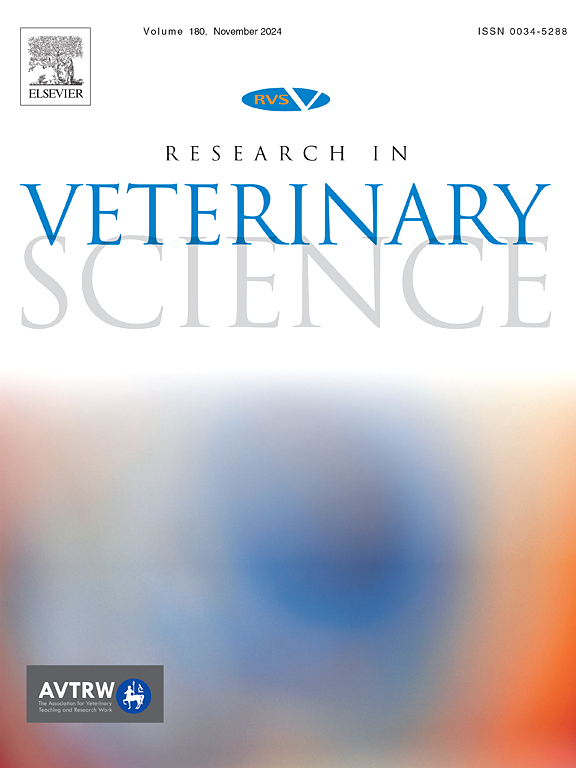牛乳细胞外小泡在兽医学中的应用前景。
IF 1.8
3区 农林科学
Q1 VETERINARY SCIENCES
引用次数: 0
摘要
细胞外囊泡(EV),包括来自生物液体(如牛奶)的外泌体或小细胞外囊泡(sEV),由于其在病理生理学和对宿主疾病状态的理解中的作用,已经引起了兽医学越来越多的兴趣。牛奶是sEV的丰富来源,含有多种核酸、蛋白质和脂质,在细胞间通讯和宿主状态调节中起关键作用。尽管从牛乳中分离和纯化sEV比从人乳中分离和纯化sEV要困难得多,但在实现sEV种群的富集和分析、促进阐明其在牛疾病中的功能作用和预后潜力方面仍然存在挑战。此外,由于其可获得性、易于收集、无创性和低成本,牛乳sEV可能成为兽药研究的良好资源。此外,基于sev的预后的发展有望通过早期发现疾病和个性化治疗策略来改善兽医医学。本文综述了牛奶sEV在疾病监测、宿主生理和免疫调节等方面的研究进展,并重点介绍了其在兽医学领域的应用前景。通过结合多个领域的知识,可以释放牛奶sEV的预后和治疗潜力,为兽医疾病的精确,早期预后和集中治疗干预的发展创造新的机会。本文章由计算机程序翻译,如有差异,请以英文原文为准。
Prospects of bovine milk small extracellular vesicles in veterinary medicine
Extracellular vesicles (EV), including exosomes or small EV (sEV) derived from biological fluids, such as milk, have garnered increasing interest in veterinary medicine because of their role in the pathophysiology and understanding of the disease status of the host. Bovine milk serves as a rich source of sEV, containing diverse cargoes of nucleic acids, proteins, and lipids, which play a critical role in intercellular communication and regulation of host status. Although it is more difficult to isolate and purify sEV from bovine milk than from human breast milk, challenges persist in enabling the enrichment and analysis of sEV populations, facilitating the elucidation of their functional roles and prognostic potential in cattle diseases. Moreover, owing to their availability, ease of collection, noninvasive nature, and low cost, bovine milk sEV could be an excellent resource for research in veterinary medicine. Furthermore, the development of sEV-based prognosis is promising for improving veterinary medicine through the early detection of diseases and personalized therapeutic strategies. In this review, we provide a comprehensive overview of bovine milk sEV related to disease monitoring, host physiology, and immune regulation, and highlight their potential applications in advancing veterinary medicine. The prognostic and therapeutic potential of bovine milk sEV could be unlocked by combining knowledge from many fields, creating new opportunities for the development of precise, early prognostic, and focused therapeutic interventions for diseases in veterinary medicine.
求助全文
通过发布文献求助,成功后即可免费获取论文全文。
去求助
来源期刊

Research in veterinary science
农林科学-兽医学
CiteScore
4.40
自引率
4.20%
发文量
312
审稿时长
75 days
期刊介绍:
Research in Veterinary Science is an International multi-disciplinary journal publishing original articles, reviews and short communications of a high scientific and ethical standard in all aspects of veterinary and biomedical research.
The primary aim of the journal is to inform veterinary and biomedical scientists of significant advances in veterinary and related research through prompt publication and dissemination. Secondly, the journal aims to provide a general multi-disciplinary forum for discussion and debate of news and issues concerning veterinary science. Thirdly, to promote the dissemination of knowledge to a broader range of professions, globally.
High quality papers on all species of animals are considered, particularly those considered to be of high scientific importance and originality, and with interdisciplinary interest. The journal encourages papers providing results that have clear implications for understanding disease pathogenesis and for the development of control measures or treatments, as well as those dealing with a comparative biomedical approach, which represents a substantial improvement to animal and human health.
Studies without a robust scientific hypothesis or that are preliminary, or of weak originality, as well as negative results, are not appropriate for the journal. Furthermore, observational approaches, case studies or field reports lacking an advancement in general knowledge do not fall within the scope of the journal.
 求助内容:
求助内容: 应助结果提醒方式:
应助结果提醒方式:


